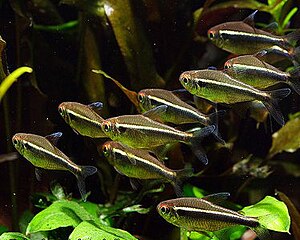Black neon
| Black neon | ||||||||||||
|---|---|---|---|---|---|---|---|---|---|---|---|---|

A small group of black neons in an aquarium. |
||||||||||||
| Systematics | ||||||||||||
|
||||||||||||
| Scientific name | ||||||||||||
| Hyphessobrycon herbertaxelrodi | ||||||||||||
| Géry , 1961 |
The black neon ( Hyphessobrycon herbertaxelrodi ), also known as the black flag tetra , is a freshwater fish that occurs in the upper Río Paraguay and other waters of the Mato Grosso . The species was by the French in 1961 ichthyologists Jacques Géry described and in honor of the fish expert and author aquaristischer literature Herbert R. Axelrod named.
features
Female black neons reach a body length of 4 cm, males stay smaller. The body is elongated and heavily flattened on the sides. The basic color is gray-brown to brownish on the upper side with a fine, dark net markings that are caused by dark scales. The ventral side is silvery. Two strong longitudinal ligaments, of which the upper one is iridescent bright blue or grass-green to yellow-green and the lower one is deep black and only blurred below, extend from the edge of the gill cover to the base of the caudal fin. The black band still extends to the middle caudal fin rays. The short, high dorsal fin is supported by two simple and nine branched fin rays, the long anal fin by four simple and 21 branched fin rays. There are 32 to 34 scales along a central longitudinal row, seven to eight of which accompany the incomplete side line . The upper section of the iris is bright red, the lower iridescent greenish. The fins are transparent with a yellowish tinge. The sexes can be distinguished by the slimmer figure of the males and their less curved belly line.
Way of life
Black neons are group fish that tend to form schools , especially when threatened from outside. They feed on worms, small crustaceans, and plant matter. In aquariums they can be found in the middle and upper water layers. Like all Hyphessobrycon species, black neons are free-spawners that spawn just below the surface of the water after violent drifting. The larvae hatch after 24 to 30 hours, depending on the water temperature. In aquarium breeding there is often an excess of males. The males do not become sexually mature until they are more than a year old.
Systematics
The black neon is not closely related to the neon fish of the genus Paracheirodon , but belongs to the genus Hyphessobrycon , which is diagnosed by the dentition and the unscaled base of the caudal fin , and mainly contains high-backed species with a reddish base color. Within the genus Hyphessobrycon , the black neon belongs to a species group of relatively elongated fish with black longitudinal stripes, which is named after the three- banded tetra ( H. heterorhabdus ) Heterorhabdus species group.
Aquaristics
The black neon was first imported in 1960 for the purpose of keeping aquariums and is still a standard offer in pet shops today. Today offspring are mostly sold.
See also
Web links
- Black Neon on Fishbase.org (English)
literature
- Günther Sterba : The world's freshwater fish. 2nd Edition. Urania, Leipzig / Jena / Berlin 1990, ISBN 3-332-00109-4 .
- Günther Sterba (Ed.), Gert Brückner: Encyclopedia of Aquaristics and Special Ichthyology. Neumann-Neudamm, Melsungen u. a. 1978, ISBN 3-7888-0252-9 .
- Axel Zarske: Hyphessobrycon herbertaxelrodi. In: Claus Schaefer, Torsten Schröer (Hrsg.): The large lexicon of aquaristics. Eugen Ulmer, Stuttgart 2004, ISBN 3-8001-7497-9 , p. 501.
Individual evidence
- ↑ Hans A. Baensch and Rüdiger Riehl: Aquariums Atlas. Volume 1, Mergus Verlag, 1997, ISBN 3-88244-101-1 .